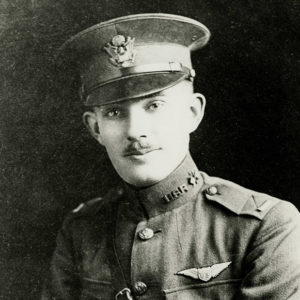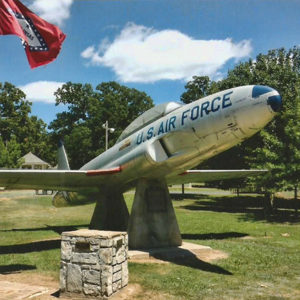calsfoundation@cals.org
Field Eugene Kindley (1896–1920)
Field Eugene Kindley, recipient of the British Distinguished Flying Cross and an Oak Leaf Cluster for the American Distinguished Service Cross, ranked third in number of aircraft downed for the United States Army Air Service in World War I. Working his way from National Guard volunteer to commissioned Army officer, Kindley commanded the 148th Squadron in France from August 1918 until the end of the war and totaled twelve confirmed kills.
Field Kindley was born on March 13, 1896, in a rural area near Pea Ridge (Benton County) to George C. and Ella Kindley. The death of his mother prior to his third birthday disrupted the family, and shortly thereafter in 1898, his father left the country to become the supervisor of an agricultural school in the Philippines. Raised by his grandmother, Cynthia Kindley of Bentonville (Benton County), until age seven, Kindley joined his father in Manila for five years then moved back to Arkansas in 1908 to live with his uncle A. E. Kindley in Gravette (Benton County); that house is now the Gravette Historical Museum.
After high school graduation, Kindley had several jobs before settling in Coffeyville, Kansas, to become a movie theater manager. He later enlisted in the state’s National Guard. Kindley transferred to the aviation branch of the Army Signal Corps and was among the first class of American pilots sent from ground school to England for flight training in September 1917.
Promoted to first lieutenant on April 15, 1918, Kindley suffered a series of mishaps in training and in his first assignment. While ferrying aircraft to the western front, he encountered heavy fog on May 5, 1918, and crashed into the White Cliffs of Dover, England. After recovering from his injuries, Kindley’s first combat assignment was to the Royal Flying Service’s Sixty-fifth Squadron. It was with the Sixty-fifth that Kindley’s combat ability emerged; he scored his first kill by downing Lieutenant Wilhelm Lehmann, commanding officer of the German Jagdstaffel 5, on June 26 over Albert, France.
In July 1918, the Americans formed the 148th Squadron, which was assigned to serve in the British sector with the RFC’s Sixty-fifth Wing near Albert, France. Kindley was one of the first pilots posted to the new unit. On July 13, Kindley earned the 148th’s first victory by shooting down a German Albatros D-3 over Ypres. The win earned Kindley brief celebrity on the British front, and he soon became the commanding officer of the 148th after Bennet “Bim” Oliver was forced into an English hospital in late July.
Later promoted to captain on February 24, 1919, Kindley’s twelve confirmed kills ranked him third in aircraft shot down during the war by Air Corps personnel, behind Captain Eddie Rickenbacker and Lieutenant Frank Luke. The Air Corps distinction is worth noting because Americans serving in the Royal Flying Corps, such as Francis Gillet and Wilfred Beaver, and with the French Air Service’s Lafayette Escadrille, in particular Raoul Lufbery, had higher kill totals than Kindley.
Kindley’s most memorable day of combat was September 27, 1918. Kindley began the sortie by dropping four small bombs on a group of German transports. Climbing from the attack, he destroyed an observation balloon and then strafed a German infantry column that had pinned down a British unit. Another strafing run on a German machine gun emplacement drew an attack upon his Sopwith from a German Halberstadt. Kindley wheeled right to destroy the Halberstadt for his eleventh kill. He continued to strafe German infantry until out of ammunition. Returning to his home base at Baizieux, Kindley noticed two Germans attacking an Allied plane. He jumped into the dogfight without ammunition in hopes of scaring off the two Fokker biplanes. The bluff worked. For this furious period of just over two hours of combat, Kindley earned his Oak Cluster and the British Distinguished Flying Cross. His final action came on October 28 with his twelfth kill, a Fokker near Bapaume, France.
After the war, Kindley was posted through a succession of squadrons in Europe and then stateside in the New York area, including occasional public relations duty. He received his last post on December 17, 1919, as the commanding officer of the Ninety-fourth Aero Squadron, made famous by Rickenbacker during the war, at Kelly Field near San Antonio, Texas. His final assignment was a flight demonstration of SE-5 biplanes for General John J. Pershing in early February 1920. On February 1, the day before Pershing’s visit, Kindley rehearsed the simulated bombing run. Diving into his target, he discovered a group of enlisted men that had wandered into the area. In an attempt to avoid the troops, he pulled back on the stick, resulting in an engine stall and failure of critical support wires in the wing. The SE-5 fell from an altitude of almost 100 feet, killing Kindley.
Kindley’s body was returned to Gravette for burial. Several monuments remain to the World War I flying ace. Gravette’s city park, a Coffeyville high school, and a World War II air base in Bermuda were all named for him.
For additional information:
Ballard, Jack Stokes. War Bird Ace: The Great War Exploits of Capt. Field E. Kindley. College Station: Texas A&M University Press, 2007.
Hudson, James J. “Captain Field E. Kindley: Arkansas’ Air Ace of the First World War.” Arkansas Historical Quarterly 18 (Summer 1959): 103–131.
———. Hostile Skies: A Combat History of the American Air Service in World War I. Syracuse, NY: Syracuse University Press, 1968.
Sloan, James J. Wings of Honor: American Airmen in World War I. Atglen, PA: Schiffer Publishing, 1994.
William M. Smith Jr.
University of Arkansas, Fayetteville
This entry, originally published in Arkansas Biography: A Collection of Notable Lives, appears in the CALS Encyclopedia of Arkansas in an altered form. Arkansas Biography is available from the University of Arkansas Press.
 Early Twentieth Century, 1901 through 1940
Early Twentieth Century, 1901 through 1940 Military
Military Gravette Historical Museum
Gravette Historical Museum  Field Kindley
Field Kindley  Field Kindley
Field Kindley  Field Kindley Memorial
Field Kindley Memorial  Field Kindley Funeral
Field Kindley Funeral  Field Kindley Grave
Field Kindley Grave  Field Kindley Induction Program
Field Kindley Induction Program 




Comments
No comments on this entry yet.